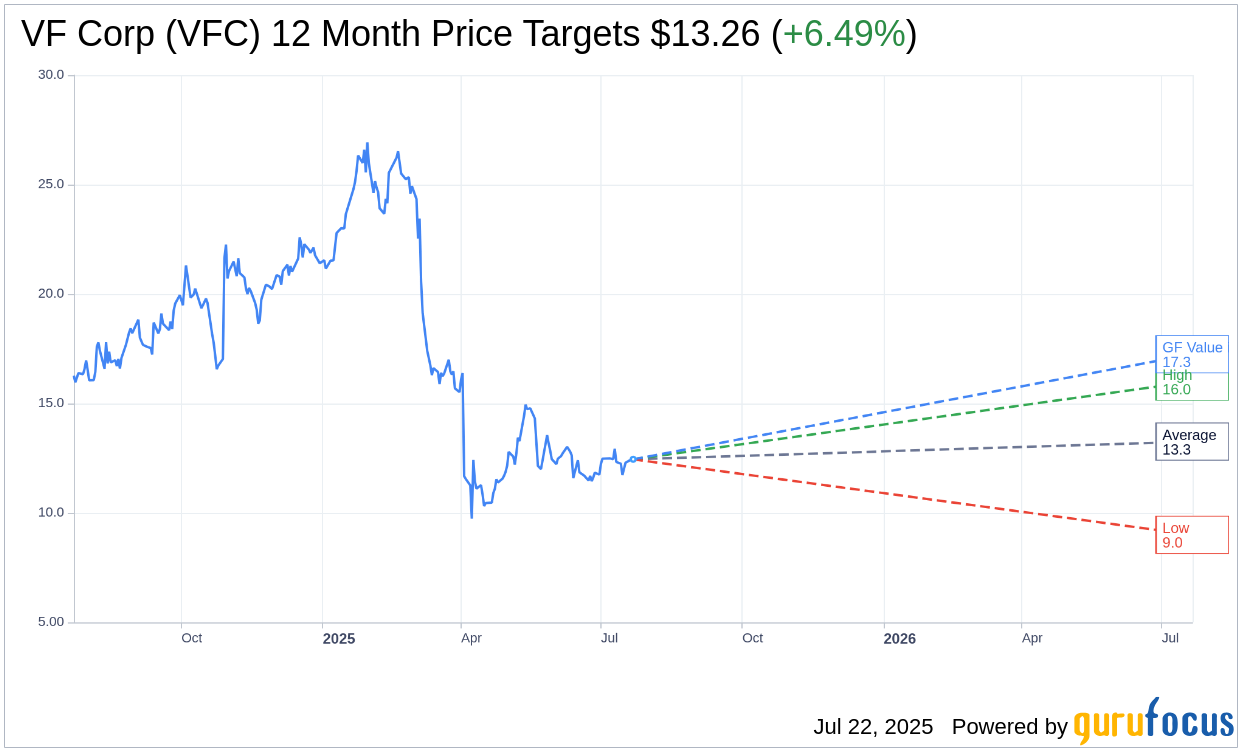Goldman Sachs has adjusted its price target for VF Corp (VFC, Financial), increasing it from $11 to $11.50 while maintaining a Neutral rating for the stock. This adjustment comes as the firm revises its outlook for the U.S. apparel and softlines sector in light of current tariff rates, which include a 30% rate for China, 20% for Vietnam, 19% for Indonesia, and 10% for other global markets.
Despite potential challenges, Goldman Sachs is optimistic about the resilience of consumer spending, suggesting minimal downside risks for sales projections in the current quarter. Nonetheless, the firm advises monitoring several potential risk factors that could impact the market.
Wall Street Analysts Forecast

Based on the one-year price targets offered by 19 analysts, the average target price for VF Corp (VFC, Financial) is $13.26 with a high estimate of $16.00 and a low estimate of $9.00. The average target implies an upside of 6.49% from the current price of $12.45. More detailed estimate data can be found on the VF Corp (VFC) Forecast page.
Based on the consensus recommendation from 24 brokerage firms, VF Corp's (VFC, Financial) average brokerage recommendation is currently 2.8, indicating "Hold" status. The rating scale ranges from 1 to 5, where 1 signifies Strong Buy, and 5 denotes Sell.
Based on GuruFocus estimates, the estimated GF Value for VF Corp (VFC, Financial) in one year is $17.25, suggesting a upside of 38.55% from the current price of $12.45. GF Value is GuruFocus' estimate of the fair value that the stock should be traded at. It is calculated based on the historical multiples the stock has traded at previously, as well as past business growth and the future estimates of the business' performance. More detailed data can be found on the VF Corp (VFC) Summary page.
VFC Key Business Developments
Release Date: May 21, 2025
- Revenue: Down 3% year-over-year to $2.1 billion, in line with guidance of negative 2% to negative 4%.
- Operating Income: Up by 400 basis points year-over-year to $22 million.
- Gross Margin: Improved by 560 basis points to 53.4% due to lower material costs, less discounting, and higher quality inventory.
- SG&A Expenses: Declined 2% as part of structural changes under the Reinvent program.
- Net Debt: Reduced by 26% year-over-year, with leverage down by a full turn to 4.1 times at year-end.
- Free Cash Flow: $330 million, with total cash flow including asset sales at $401 million.
- Vans Revenue: Down 20% in the quarter, with strategic reductions in unprofitable business.
- The North Face Revenue: Up 4% in Q4, driven by DTC performance.
- Timberland Revenue: Increased by 13% in Q4, with higher margins from lower discounts.
- Adjusted Loss Per Share: Negative $0.13 compared to negative $0.30 in Q4 of last year.
- Inventory: Decreased by 4% or $71 million at the end of the year.
- Q1 Revenue Guidance: Expected to be down 3% to 5% on a constant dollar basis.
- Q1 Operating Loss Guidance: Expected to be between $110 million to $125 million.
For the complete transcript of the earnings call, please refer to the full earnings call transcript.
Positive Points
- VF Corp (VFC, Financial) reported a significant improvement in operating income, up by 400 basis points year-over-year, exceeding guidance.
- Gross margin improved by 560 basis points compared to the previous year, driven by lower material costs and less discounting.
- The Reinvent program led to a 2% decline in SG&A expenses, contributing to improved operating profitability.
- Net debt was reduced by over a quarter compared to last year, with leverage reduced by a full turn, aligning with the medium-term goal of 2.5x leverage.
- The North Face brand showed positive performance with a 4% revenue increase in Q4, driven by strong direct-to-consumer sales.
Negative Points
- Overall revenue declined by 3% in the fourth quarter, in line with guidance of negative 2% to negative 4%.
- Vans brand revenue was down 20% in the quarter, with a significant portion of the decline due to strategic actions to eliminate unprofitable business.
- The APAC region's turnaround has been slower, impacting overall performance.
- Direct-to-consumer (DTC) sales were down 3%, primarily due to soft traffic.
- The company is facing potential impacts from newly implemented tariffs, with an unmitigated annualized cost impact of approximately $150 million.
